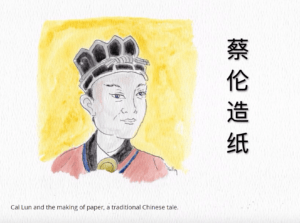About this Story:
In ancient China, people had to use bamboo or silk to write. Bamboo is cheap but heavy while silk is light but expensive. After trials and errors, Cai Lun finally found out a way to make light and cheap paper, with which everyone can read and write. Cai Lun and his paper changed the world.
 Download the story in PDF version here to print for classroom or home use.
Download the story in PDF version here to print for classroom or home use.
Download the narrated iBook for use on iPad and other electronic devices.
Big Idea:
Through learning about Cai Lun and the making of paper, students would have an understanding of the concept of cause and effect, which little things can make great changes to the world.
Connections (Subject Area):
Math: Compare and document the results of comparisons with the symbols >, =, or <, and justify the conclusions, e.g., by using a visual fraction model. Compare 不好、好、很好、非常好from bad to good in the correct order using the < sign
Science: Identify examples where human activity has had a beneficial or harmful effect on other organisms (e.g., deforestation). Recycle discussion
Social study: Identify causes and effects using examples from history. Cause and effect discussion;
Language arts: Describe the relationship between a series of historical events or scientific ideas or concepts in a text, using language that pertains to time, sequence, and cause/effect.
Comparisons: Compare and contrast education in ancient China to our education using a Venn diagram; Compare and Contrast Short-term and Long-term effect.
Community:
Choose an important invention and present to class with its story.
Language Functions & Forms:
- SWBAT describe two positive things or two negative things using the structure 又…又…
- SWBAT explain cause and effect using the structure 因為…所以…
- Vocabulary: 紙、書、讀書、寫字、便宜、貴、錢、輕、重、皇宮、努力、非常、竹子、絲布
Culminating Assessment:
Interpretive Task: Read the story of Bi Sheng and printing technology in ancient China. Explain why printing technology made great changes to the world; compare and contrast the story of Cai Lun and Bi Sheng. Discuss in small groups on the differences and similarities between the two stories.
Interpersonal Task: In small groups, choose an important invention and present to the class with its story. Provide details on how did this invention changed the world.
Presentational Task: In small groups, discuss what you think is the most important invention that changed the world. Support your opinion with facts learned in the class.
Differentiated Activity
Low Group
- Provide pictures with pinyin
- Use simple language
- Provide sentence starters and sentence frames
- Allow students to draw and label, cut and paste, or fill in the blank for assessments
Middle Group
- Provide complete sentences with pinyin and pictures
- Provide sentence starters
- Ask students to produce complete sentences, which can be short, for assessments
High Group
- Provide complete sentences with some pinyin
- May or may not provide sentence starters
- Ask students to produce sentences with more details for assessments